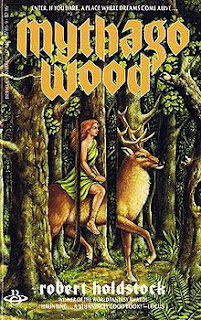 Richard Holdstock wrote a great fantasy novel called Mythago Wood. Centerpiece of the novel is the mysterious Ryhope Wood. I am not going into detail about the novel itself. The part that really inspired me was the fact that Ryhope Wood was larger on the inside than the outside. Much larger.
Richard Holdstock wrote a great fantasy novel called Mythago Wood. Centerpiece of the novel is the mysterious Ryhope Wood. I am not going into detail about the novel itself. The part that really inspired me was the fact that Ryhope Wood was larger on the inside than the outside. Much larger.When I read this in the 80s, I challenged myself to come up with a to come up with gamable way of mapping something like this. I only have half of the original handdrawn map so I dug through what I recently drawn and threw together some examples of doing this.
I call places that are larger in the inside than the outside Faerie Wolds.
First think of a line. This represents the normal world.
Next think of a line with a mushroom like shape protruding upwards. It is connected to the line by a thin neck. This is a side profile of a faerie wold. The following diagram illustrates.
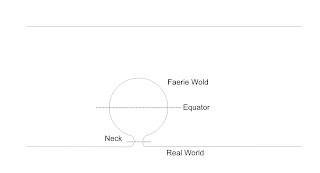 So how you map something like this? First you draw the outline of the next. This regional map of City-State from my Majestic Wilderlands shows an area that is the "neck" of a Faerie Wold.
So how you map something like this? First you draw the outline of the next. This regional map of City-State from my Majestic Wilderlands shows an area that is the "neck" of a Faerie Wold.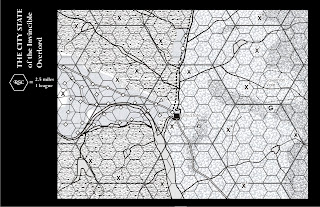 Each small hex is 1 league, or 2.5 miles. The distance a person can walk in an hour. The larger hex is 5 league. The hex that show up on my large scale maps. Note near the upper right corner near the letter G is Savernari Vale. This valley is noted for it's uncanny nature and is avoided by Purple Claw Orc, Orc Bounty Hunters, and City-State Patrols.
Each small hex is 1 league, or 2.5 miles. The distance a person can walk in an hour. The larger hex is 5 league. The hex that show up on my large scale maps. Note near the upper right corner near the letter G is Savernari Vale. This valley is noted for it's uncanny nature and is avoided by Purple Claw Orc, Orc Bounty Hunters, and City-State Patrols.The neck of the Wold is the dashed line. Note it is an irregular shape, for your first attempt you may want to try doing this with a circular neck and polar plot sheets, but any shape can be used.
Next I grab a piece of paper, hex, square, or plain, that you are going to map with. I recommend that it be a lot bigger than than the size of the next. Draw a outer boundary far away from the neck. This outer boundary represents the equator of the Faerie Wold.
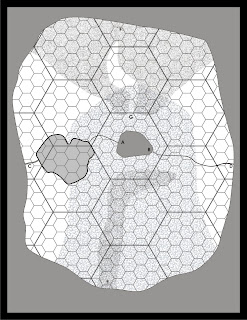 Next grab another sheet of mapping paper and redraw the exact same outer boundary. When drawing the outer boundary keep in mind you want to make it easy to locate corresponding points on the edge for when the players crosses the wold's equator.
Next grab another sheet of mapping paper and redraw the exact same outer boundary. When drawing the outer boundary keep in mind you want to make it easy to locate corresponding points on the edge for when the players crosses the wold's equator.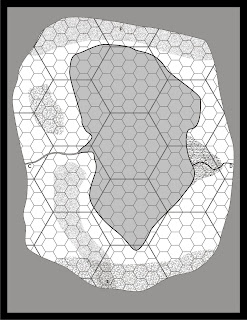
Next take any terrain feature that enters through the next and draw a little bit of them coming through the neck boundary on the first wold map. After you sure you have it lined up, then map away. When a terrain feature cross the equator note where the points are and make corresponding marks on the other wold map to continue the feature. The example wold above show how I handle rivers, forest and hills.
So how this does it work. A group of players are traveling up river and cross into the Wold at point A. They continue up river traveling to the left on the first Wold map (representing the bottom half of the Wold), until they hit Point C.
Now they cross over onto the second wold map, at point C. Continuing travelling up river and wondering why it is getting larger. Then they hit the sea at the top of the wold. They are lucky and manage to make it to the river on the other side and continue through the swamp, still going up river the whole time, exiting the top half at point D.
They still continue going up river, noting it is finally narrowing as expected. Eventually they cross the neck boundary at point B remerging in the real world. Throughly confused at travelling 34 leagues instead the expected 3 leagues.
Depending on how big the wold is compared to the neck it can be easy to get lost in one. The party can keep to going in circles until they manage to find the neck boundary again. You can be tricky and put duplicate terrain to confuse the issue further. Note on the first wold map, point G, this is similar to the gap in the hills marked at Point G on the City-State map. A party traveling south would enter the wold and head to Point and see the expected gap in the hills.
Next I will write about how to apply this to dungeons. You haven't seen a funhouse dungeon until you been in one with a wold inside of it.
9 comments:
Okay, my head now hurts! I need a lie down.
Sounds awesome though.
- Neil.
So the woods are kind of like the TARDIS from Dr. WHO fame?
That one way of thinking of it.
Interesting. These wolds -- do they act as waypoints or safe zones for the fey?
Fae equivalent of castles or cities.
I recently sketched an interior map on a piece of paper like the one in the following puzzle...
http://mathteacherorstudent.blogspot.com/2010/07/paper-puzzle.html
Flip the different bits around as the PCs explore. Give a "closet? When we came through that door it was a kitchen" effect.
I freaking love that book--now I'm going to need to read it again!
I can't say I completely understand your directions, but it sounds like an exceedingly awesome thing to add to a map.
Now, how about adding the bit where things get more primal the farther towards the center of the Wold you go?
I'd urge to make these into a two separate submissions to Fight on!
Love that diagram. Nice work, Rob.
Thanks for sharing this information. I learned a lot from your post and I’m excited to apply some of these ideas to my own situation. Looking forward to your next update!
World map wood
Post a Comment